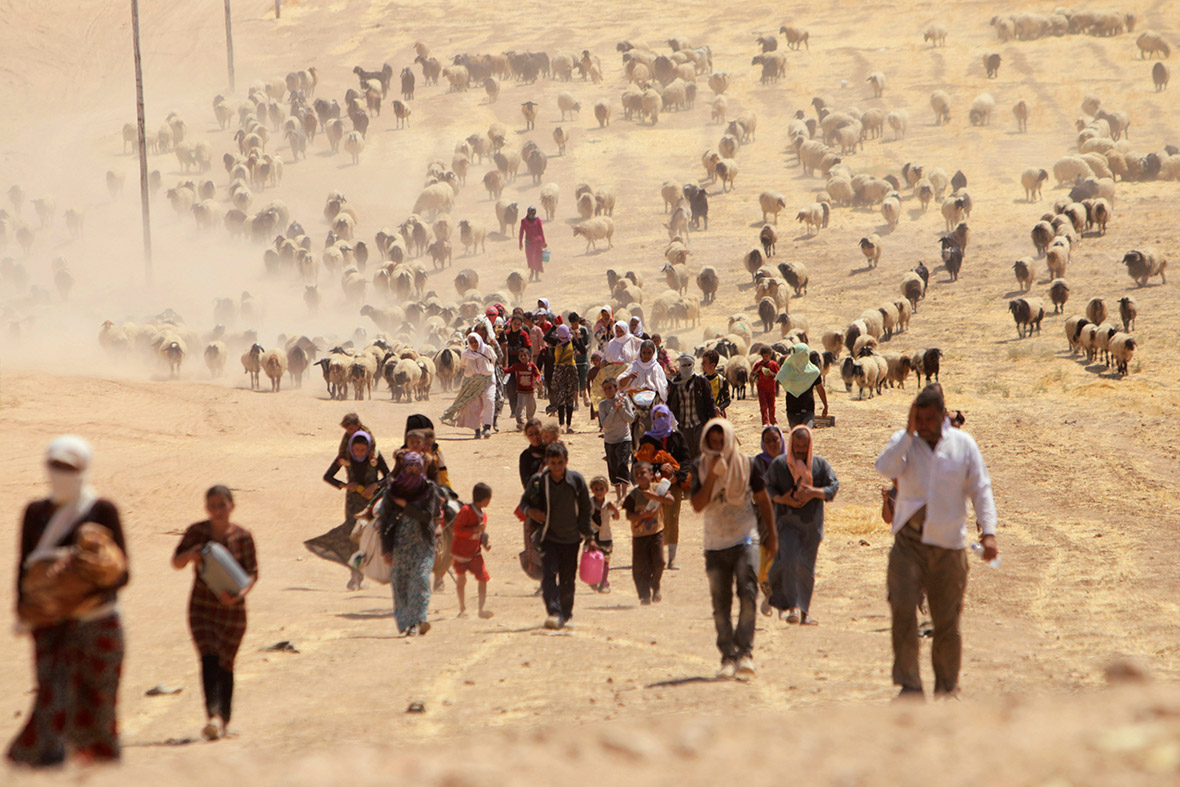State borders in the Middle East have been in flux for
millennia, with the strongest ruler of the day vying for control over fertile
land, trade routes, and major water sources. Today, the region is populated
with many countries whose modern-day borders were arbitrarily delineated by the
British-French Sykes-Picot Agreement, whose peoples have been in a constant
struggle to reclaim what they believe is rightfully their land. Much of a
state’s validity comes from being able to show that they have the oldest claim
to the region, so what happens when a people’s physical life, when their
physical history is deleted?

What happens when a city is blown to smithereens
by explosive charges, as with mosques and churches in Mosul, instead of falling
to salvageable ruins? What happens when an entire people is removed from their
ancestral homeland, fleeing to a neighboring country, leaving no trace of their
existence in the former land? Or, in the grand scheme of political and
strategic interests, is the individual human story irrelevant?
In what appears to be an effort to rewrite the history and
shape the future of Iraq and the Levant, the Islamic State (IS) terrorist group
has reportedly destroyed, damaged or occupied up to 45 Christian institutions
in Mosul and around Iraq. IS drew international ire for demolishing with the
Shrine of the Prophet Younis, also known as “Jonah’s Tomb,” a site revered by
both Muslims and Christians.
Additionally, the Sunni Muslim group has launched a campaign of
persecution against religious minorities in their controlled territory,
specifically Turkmen, Shabaks, Yazidis and Christians, demanding that they
convert, pay “tribute” money, or flee on pain of death. Unsurprisingly, nearly
a quarter of a million people have chosen to flee their homeland, and Mosul and
surrounding areas may soon lose all trace of their historical religious
diversity.
Where do the people go? In any conflict between two parties
seeking control of a state or region, what are the humanitarian costs, and what
do we, as a civilized state in the 21st century do to minimize civilian
harm? In the case of an estimated 20,000 to 40,000 Yazidi people trapped on
Mount Sinjar, the US and the UK opted to airdrop food, water, and other
supplies, but stopped short of physically assisting in efforts to clear an
escape route for the people trapped on the mountain.

US Special Operations forces landed on Mount Sinjar last
week to assess the situation and determine whether a rescue operation would
make a difference, ultimately determining
that there were far fewer refugees than expected stranded there, making a
rescue mission less likely. Defense Department officials estimated that the
Yazidi refugees had been leaving the mountain at a rate of about a thousand
people per day, and that only several thousand people were left, and would be
able to make their way off the mountain unaided. What this assessment failed to
take into consideration was that the people left on the mountain were those
least likely to be able to leave – the elderly, the sick, and the youngest
children. Reports then announced that Syrian Kurdish forces, allegedly aided by
US airstrikes, had been able to clear a path from Mount Sinjar to refugee camps
in Syria to escort several thousand people to safety. Conflicting reports have
come from aid agencies working on Mount Sinjar, Kurdish officials and other
Yazidi refugees on both the number of people still stranded on the mountain and
their ability to make the grueling trek off the mountain to safety.
On the flip side, reports came in early Sunday afternoon
that Kurdish forces in northern Iraq had retaken control of the Mosul Dam.
Assisted by US air strikes, Kurdish ground forces began another operation on
Sunday morning to oust the Islamic State (IS) militants from the Mosul dam and
surrounding areas, successfully capturing this strategic site, and beginning
the process of clearing any mines or other explosives from the area. As Vicky
explained in “The Road to Baghdad Part 3: The Reckoning,” control of the Mosul
Dam provides control over the region’s water and electricity. The Mosul Dam in
particular, built on a bed of highly soluble gypsum, requires constant
maintenance to counteract structural flaws, as an accidental burst would spell
death for up to half a million civilians. US concern over this strategic site
dates back to the Iraq War, and US military involvement to retake the dam is
unsurprising.
There is, to me, a stark contrast between the efforts taken
to retake control of the Mosul Dam and the efforts taken, or rather, not taken,
to prevent a potential genocide of an entire people trapped in harsh conditions
on Mount Sinjar. The Obama Administration stated that US airstrikes were
initiated both for strategic and humanitarian reasons, but the success of the
latter goal is nearly impossible to quantify. Ideally, humanitarian success
would imply ousting IS from the region and a repatriation of the displaced
minority, but if the history of the foreign engagement in Iraq and the Levant
serves as any precedent, the chances of this happening are slim to none.
When allocating resources for engagement in Iraq and the
greater Middle East, emphasis has been and continues to be placed on the
security of strategic resources, and it would be naïve to expect otherwise. On
a grander scale, despite the work of humanitarian aid groups, the UN and
journalists to expose the depth of impact on people, it seems that the one
constant throughout history that remains true today is that individual human
story is indeed less important, that we will stand by as an entire people
disappears from a region, and that we will cry foul, but our actions will
expose our true colors.
No comments:
Post a Comment